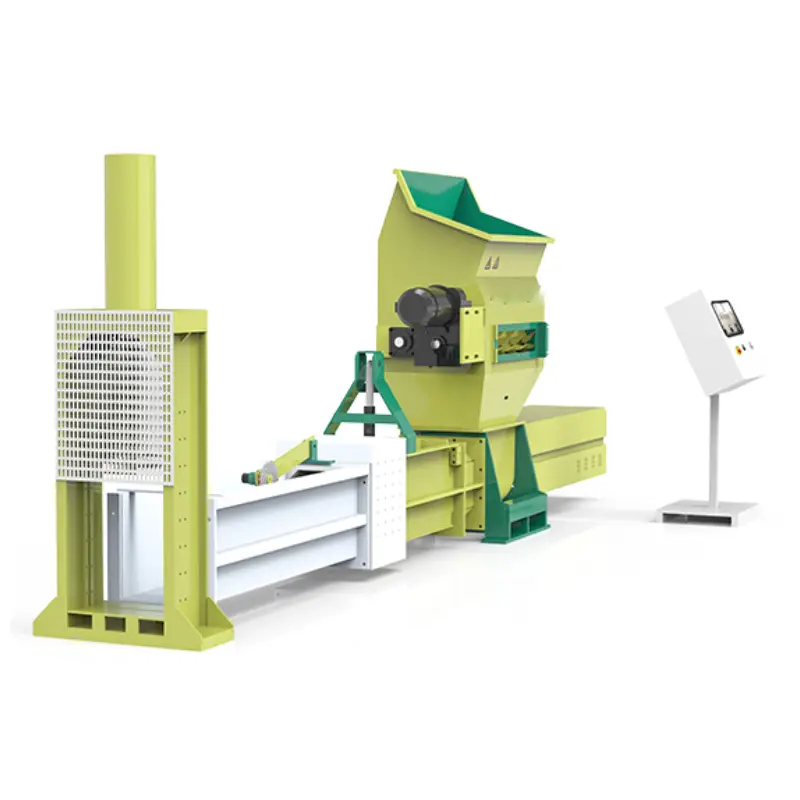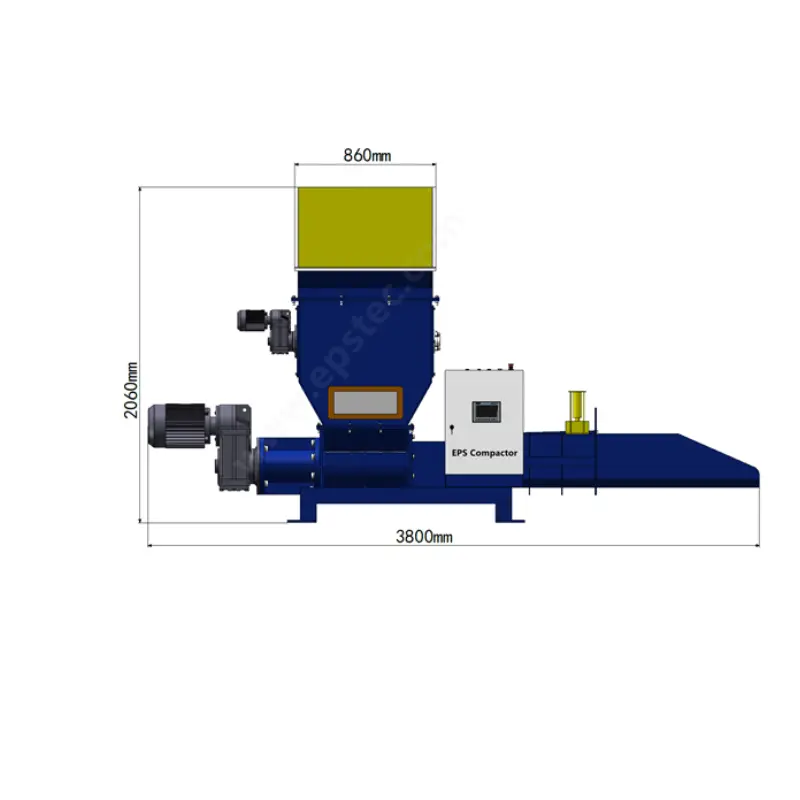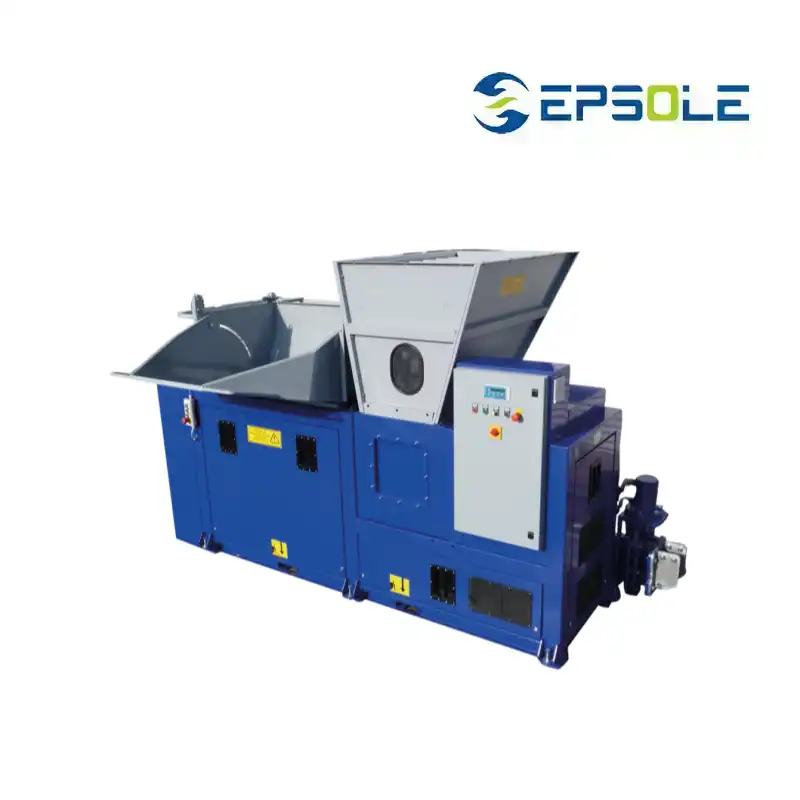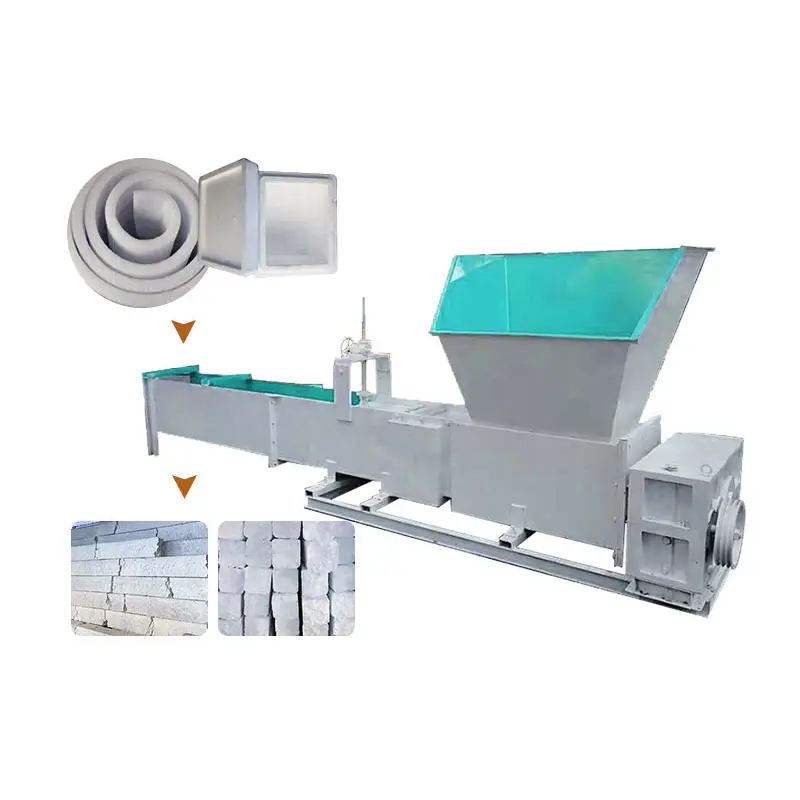
EPS Compactor: Increase Efficiency & Profits
Crush clutter and boost your bottom line! Eps Compactor maximizes space, minimizes waste removal costs, and streamlines workflow. Get a free quote today and see how much you can save.
Our EPS Compactor
To make the best decision, it’s important to consider your specific needs and research different EPS compactor options. However, the reasons above highlight the potential benefits of choosing this company’s EPS compactor.

- Reduced Waste Volume: Their compactor can significantly reduce the volume of your EPS waste, typically by a ratio of 40:1. This frees up valuable storage space and cuts down on the number of waste pickups you need.
- Cost Savings: By reducing your waste volume, you’ll likely save money on hauling and disposal fees. In some cases, compacted EPS can even be sold to recyclers, generating additional revenue.
- Environmental Benefits: Diverting EPS waste from landfills is good for the environment. Compaction makes recycling more efficient and cost-effective, encouraging responsible waste management.
- Variety of Options: They may offer a range of EPS compactor models to suit different waste volumes and business needs.

EPS Compactor Machine benefits
Big Shrink, Big Savings: EPS compactors are like magic machines for bulky EPS waste. They crush it down by up to 50 times, freeing up storage space and significantly reducing the number of pickups you need. This translates to big cost savings on hauling and disposal fees.
Eco-Friendly Bonus: Compacting EPS makes recycling more feasible. Instead of taking up space in landfills forever, the compressed EPS can be recycled into new products. This is a win for both your wallet and the environment.
Variety and Simplicity: There are different compactor sizes to fit various business needs. Most are user-friendly, requiring minimal training for your staff.
Overall Boost: An EPS compactor can benefit your business in multiple ways. It saves space and money, promotes eco-friendly practices, and keeps your operations running smoothly.
Various EPS Compactors

EPS Foam Compactor
Drowning in bulky EPS foam? Our compactors crush it down by 50%, saving space and slashing disposal costs. Recycle responsibly and boost your bottom line. Get a free quote today!

EPS Screw Compactor
Reduce waste and boost profits with the powerful EPS Screw Compactor! This space-saving machine crushes bulky EPS foam by up to 50 times, minimizing storage needs and hauling costs. Turn your EPS waste into a manageable resource, and potentially even a revenue stream through recycling. Don’t wait – contact us today to learn how an EPS Screw Compactor can revolutionize your waste management!

EPS styrofoam compactor
Drowning in bulky EPS waste? Our EPS compactor crushes it down by 50 times, slashing storage needs and disposal fees. Plus, compacted EPS can even be recycled! Stop wasting space and money – contact us today to learn how an EPS compactor can benefit your business.
EPS Compactor Machine Applications
Packing Material Reduction
EPS is a popular packing material used to protect electronics, appliances, and other fragile items during transport. Businesses that generate a lot of packing material waste can benefit from an EPS compactor. The compactor can significantly reduce the volume of EPS waste, saving on storage space and disposal costs. Additionally, compacted EPS is sometimes easier to transport for recycling.
Food Service Industry
Many food service establishments use EPS coolers and containers for transporting food and beverages. These EPS items can take up a considerable amount of space in landfills. EPS compactors can help food service businesses reduce their environmental impact by compacting EPS waste for recycling.
Retail Businesses
Retail stores often receive products packaged with EPS. An EPS compactor can help retail businesses manage this type of waste by reducing its volume. This can free up valuable storage space and potentially generate revenue by selling compacted EPS to recyclers.
FAQs about EPS Compactor
what is EPS compactor
An EPS compactor, also named EPS compactor machine, styrofoam compactor, is a machine specifically designed to crush and compress Expanded Polystyrene (EPS) foam, commonly known as Styrofoam.
Here’s a breakdown:
- Problem: EPS is a lightweight but bulky material that takes up a lot of space in landfills and isn’t biodegradable.
- Solution: The compactor tackles this issue by squeezing the air out of EPS foam, reducing its volume by up to 50 times. Imagine a pile of packing peanuts – the compactor transforms them into a denser, more manageable block.
Benefits:
- Saves Space: Frees up storage space in your business.
- Reduces Costs: Less waste to haul means less money spent on disposal fees. In some cases, compacted EPS can even be sold for recycling.
- Environmental Impact: Makes EPS recycling more efficient, diverting waste from landfills.
How does an EPS Compactor work?
An EPS compactor uses a two-stage process to break down and compress bulky EPS foam into a denser block:
Pre-crushing:
EPS waste is fed into the compactor’s hopper, a large opening at the top.
Some compactor models may have a built-in pre-crushing mechanism that uses blades or rotors to shred the EPS foam into smaller pieces.
This initial breakdown makes the material easier to handle and compress in the next stage.
Compaction:
The pre-crushed EPS pieces move into the compaction chamber. This chamber typically houses one of two mechanisms:
- Screw Compactor: A large screw auger pushes the EPS foam through a decreasing chamber size. The decreasing space forces the air out of the foam, compressing it into a dense block at the end.
- Hydraulic Compactor: A powerful hydraulic press squeezes the EPS foam between two plates, forcing out air and compacting it into a solid block.
Block Ejection:
Once compacted, the EPS block is automatically ejected from the machine, ready for storage, transport, or recycling.
Here are some additional points to note:
The specific operation may vary depending on the model and manufacturer.
Some EPS compactors are designed for continuous feeding, while others require stopping and starting between loads.
The size of the resulting compacted block will depend on the compactor’s capacity and the initial volume of EPS waste.
EPS compactors offer a practical solution for businesses and organizations that deal with significant amounts of EPS foam waste. They help manage storage space, reduce disposal costs, and contribute to a more sustainable waste management process.
How to use EPS compactor?
Here’s a general guide on how to use an EPS compactor:
Preparation:
- Read the manual: Always refer to the manufacturer‘s instructions for specific operation details and safety precautions before using the EPS compactor.
- Power Up: Ensure the compactor is properly plugged in and powered on according to the manual’s instructions.
- Clear the Hopper: Before starting, make sure the hopper, the large opening at the top of the compactor, is clear of any debris or leftover materials.
Operation:
- Feeding the EPS: Most compactors are designed to handle loose EPS materials like packing peanuts, takeout containers, and protective packaging. Avoid putting in any contaminants like plastic bags, tape, or food residue, as these can damage the machine or compromise the recyclability of the compacted EPS.
- Feed Rate: Some compactor models may have a designated feed rate, indicating the recommended amount of EPS to add at a time. Don’t overload the hopper, as this can lead to jamming or malfunction.
- Crushing (if applicable): If your compactor has a pre-crushing mechanism, the EPS will be shredded as you feed it into the hopper.
- Compaction: Once the EPS enters the compaction chamber, the machine will automatically compress it into a block. This process typically takes a few seconds to a minute depending on the model and the amount of EPS being compacted.
- Block Ejection: The compacted EPS block will be automatically ejected from a designated opening in the machine. Depending on the model, there might be a tray or chute to catch the block.
After Use:
- Power Down: When finished using the compactor, turn it off and unplug it according to the manufacturer‘s instructions.
- Emptying the Hopper: If there’s any remaining EPS in the hopper, carefully remove it and dispose of it properly.
- Cleaning: Wipe down the hopper and exterior of the compactor with a damp cloth to remove any dust or debris. Refer to the manual for any specific cleaning instructions.
Safety Tips:
- Never put your hands or any other objects into the hopper while the compactor is running.
- Be aware of moving parts during operation.
- Wear safety glasses and gloves when using the compactor, especially if handling large pieces of EPS.
- If the compactor jams or malfunctions, stop using it immediately and consult the manual or contact the manufacturer for troubleshooting.
Remember, this is a general guideline, and specific steps may vary depending on the model. Always prioritize safety and follow the manufacturer‘s instructions for optimal use of your EPS compactor.
